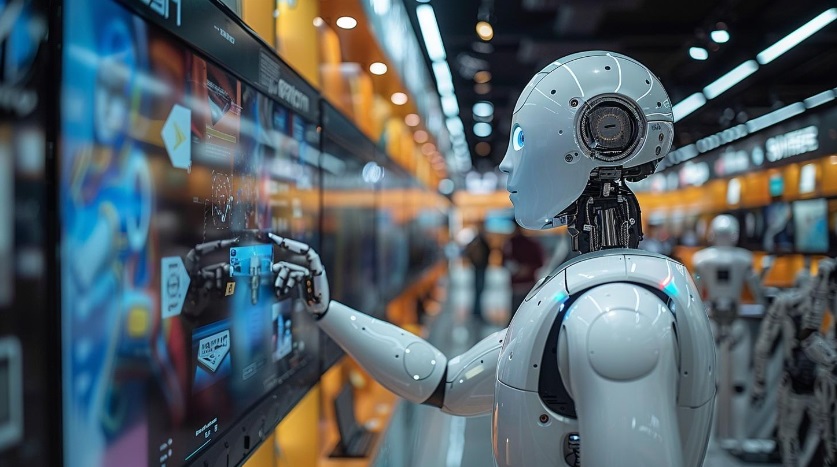
As society is embracing the use of modern technology, usability is the key to any successful business venture. In the current world, enhanced technologies of artificial intelligence are revolutionizing the user experience with web applications, programs, and services. The application of AI for building consumer interaction that is more suited, time effective, and responsive hence leading to increased user satisfaction, usage, and loyalty.
This article examines the current generative AI systems in engaging the user and addresses some of the fundamentals of how AI technologies are making a difference.

1. Personalized Experiences Through Data
Among the most meaningful applications of modern generative AI development services in USA, one can highlight the learning of user sub-profiles for a personalized experience. Using the data provided by users, AI systems find out patterns of behavior, choices, and engagement. It also allows to development of concept solutions for personalized recommendations, interfaces, and content that would encourage every user’s engagement.
For instance, the streaming services Netflix and Spotify in recommending specific films or series and specific tracks rely on artificial intelligence. They offer specific recommendations that increase user satisfaction since the time and efforts needed to find necessary content are minimized while the relevance of the offered recommendations is maximized.
2. Significance of Natural Language Processing (NLP) for Improved Interaction
The application of NLP in generative AI systems has enhanced the way humans interact with machines. This makes AI-powered chatbots and virtual assistants incorporate NLP to enable them to respond to natural human language. This makes communication to be more natural and not restricted by a programmed series of responses, thus making the process seamless for users.
Such interfaces as ChatGPT and Alexa have shifted how people engage with the services. Users no longer need to go through multiple settings even while typing certain commands but they can speak or even type in a natural language that they use in their day-to-day activities. Organizations that have implemented these AI technologies can offer customers support at any time of the year and round the clock, this enhances the customer experience and organization’s service delivery.
3. Adaptive User Interfaces
One of the new advancements in generative AI is that they can create User Interfaces that adapt. Such interfaces can be changed depending on the usage, preference or requirement of the users. For example, websites or applications can transform the layouts of designated interfaces, recommend certain functions, or call attention to related objects according to the user’s past behavior.
Think about a news site changing the layout of its front page to accommodate the articles you open most frequently. Or a search engine that displays products similar to what you have been searching for lately. These adaptive interfaces help to minimize the amount of work users have to do to find what they want; which increases the entertainment factor.
4. AI-Powered Content Creation
Of the use cases that can already be classified as a success story for generative AI, content creation has been notably impacted, to the advantage of businesses as well as users. Writing and posting blogs, product descriptions, and social media posts are some of examples of the many advantages of AI-generated content in that it can provide a constant stream of good quality content regardless of the size of the human team.
To users further, interactions can be improved through the use of AI and the information that it produces is more relevant and updated. For instance, it can be a product description on online shops that adapts to the current tendencies or other customers’ feedback. In the same way, AI can create custom email marketing messages, which using the client’s history will attract more attention and convert more visits into sales.
5. Visual and Voice Recognition
Also, the recent generative AI systems have enhanced the natural interaction of the user through the integration of sight and voice impairments. From security applications such as recognizing a face to let access a building or personalized experience such as a voice command to control home devices, these technologies enable hands-free and secure interactions.
For instance, voice-controlled solutions can identify an individual’s voice and proceed to give individual recommendations. Likewise, facial recognition technology in mobile devices includes unlocking the mobile, accessing a secure application or even making payments within a short time.
6. Predictive analytics and user behavior prediction.
A generative AI system, through user behaviour patterns developed from previous-source interactions, can estimate what a user could require next. This predictive function is especially important in such fields as e-commerce, where such expectations result from increased conversions.
Users can be sold products that they have previously bought or even products that they have looked at, make it easier for business to market their products and put promotions. The same can be said for generative AI systems in content platforms, where the technology can forecast which articles, videos or any form of content users are most likely to interact with so that they are recommended only that which is relevant to them.
7. Seamless Multilingual Interactions
The expansion of the internet across the globe has called for multi-lingual interfaces for the users. In generative AI systems backed up with translation capabilities, people can now experience smooth communication across various languages. This creates opportunities for companies to appeal directly to the global markets at a relatively low cost of localization.
People are able to comfortably engage with websites, industries’ help desks, or even smart voice systems in a language they are comfortable with. This capability improves engagement since it brings out a feeling of familiarity to the people due to the fact that everyone will be accessing the services or content in their own language.
8. Incorporation of the users’ feedback in real-time and the subsequent readjustments.
Using generative AI architecture, AI agents can learn in real time, depending on the feedback received from the consumers. For instance, if the user has made a comment regarding an interaction with a chatbot he increased the chances of the next response to fit the user’s need. This brings the idea that these AI driven systems get wiser as time passes thus enhancing the ways they interface with users.
In gaming for example, the difficulty level of the game can be adjusted with the help of AI depending on the capability of the player. This makes the whole thing more exciting as one is able to get a feel of the game improving on their sense of output.
Conclusion
Modernization generative AI systems are putting through a drastic shift in the interactions carried out by the users with the help of technologies. Through individual approaches, user friendly interfaces, and smart suggestions, such artificial intelligence systems are making the user experiences richer and satisfying. Today, businesses that are implementing these technologies that include, adaptive interface and predictive analytics among others are distinguishing themselves in the current competitive market.
Such advantages are expected to increase in the future as the technology of generative AI develops in remote locations increases dramatically. Companies that invest in these various applications of AI will find that they get more satisfied and loyal customers since they will have had better interactions with the applications that the companies have implemented in their operations.
Author Bio
Raj Joseph – Founder of Intellectyx, has 24+ years of experience in Data Science, Big Data, Modern Data Warehouse, Data Lake, BI, and Visualization experience with a wide variety of business use cases and knowledge of emerging technologies and performance-focused architectures such as MS Azure, AWS, GCP, Snowflake, etc. for various Federal, State and City departments.
